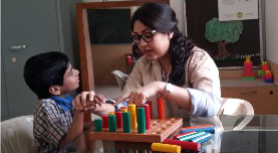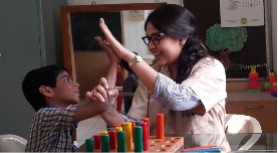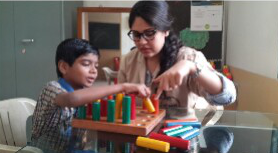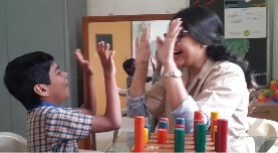ANIMAL ASSISTED THERAPY (AAT)
Case »
A Golden Retriever, five years of age, named Zoe, has been delighting the students and staff. A girl student has been in sessions over the past four years and her motivation has always been high to be part of the sessions. Changes observed during this academic year are that she is trying to repeat meaningful statements up to three words, with better clarity in speech. She is able to call Zoe by name whenever she sees her in the School premises and tries to describe Zoe’s activities during the session on her own. All these improvements would help her towards being a part of a social group and learn group activities.
Zoe willingly lets the girl sleep on her which has a calming effect resulting in the introduction of other activities like counting, tracing alphabets or working on puzzles. The dog shows love which makes the student happy.
ART BASED THERAPY (ABT)
Case »
A seventeen years old boy with mild level intellectual disability was sent for therapy because of his negative thinking and arrogance. He was a stubborn child with a lot of expectations of himself. There was lack of emotion or compassion. After therapy, he has become positive towards change and has started developing empathy towards his peers.
COUNSELING
Case »
A fourteen years old boy, with mild level of intellectual disability, started going for counseling sessions due to low confidence and non-expressive behaviour. He was also supressing his expressions in group play. Post therapy, he now openly expresses his issues and is much more confident in all areas. He has improved in academics and scores well in examinations.
SPEECH THERAPY
Case »
An eight year boy with spasticity has shown marked improvement in speech imitation skills. He has started to greet the teachers and his classmates which earlier were achieved with therapist. He even has started uttering short 2 words sentences. He now looks at the said objects and names them after therapist. As per class teacher meaningful speech has started in classroom.
PHYSIOTHERAPY
Case »
An eight year boy with spasticity, his goals focuses on stop his drooling, to improve core muscle & back extensor strength, initiate standing without support. The goals which were set for him are fully accomplished. He has started standing without support and he is manageable at home and school.
OCCUPATIONAL THERAPY
Case »
A five years old girl with moderate mental retardation, started with occupational therapy sessions for improvement in her motor and sensory issues, independence in activities of daily living, compliance and overall intelligence.
After continuous occupational therapy interventions, she has developed good compliance and is easy to manage anywhere. Her gross and fine motor functions have improved, along with her dynamic balance and gravitational insecurity. She has started performing parts of her daily chores on her own.
BEHAVIOR THERAPY
Counseling Process
- Assessment
- Rapport development and alongside Identifying the reinforces - Identifying the functions of behavior
- Goal setting
Work is done towards improving the cognitive processes, behavior is modified, socio-emotional needs are addressed and all this is done using play as a medium.
Age 11, a student of the Early Intervention Program Section, information gathered from her case reports indicate that she is functioning at the level of Moderate Mental Retardation.
The main complaints include crying throughout the day and non compliance when made to perform a task (as reported by the class teacher).
The child uses crying / wailing as a function of behaviour to:
- Seek attention
- Avoid performing tasks
- Escape from situations where the child is made to perform
- Gain tangibles
Identification of the prompts to be given which would prove to be effective and aid the learning process.
- Visual, Gestural, Verbal and Physical
Along with these modeling out the desired behavior or action in front of the child proves to be helpful.
The process also includes identifying what reinforces the child positively in order to keep that reinforcer contingent on a particular desired behavior.
As the child here demands attention it is identified as a positive reinforcer for the child which is contingent on the display of the desired behavior.
Also, the child likes to play with the ball and look into the mirror. Other reinforces like giving a broad smile to the child while looking into her eye when she follows instructions and shows little or no resistance, clapping for her and giving a hand gesture in the form of a 'high five' also works to motivate the child in order to perform well.
At a stage when all these things are identified and rapport is established effectively Goal setting is done.
An over view of the work done towards achieving the goals set in the counseling sessions:
- The child is exposed to games and activities that are colorful and novel; aim - to get her to attend to the task.
- Make her look at the activity in order to work on her joint attention. Activities to achieve the goal would be: e.g.- picking up an object and placing it in a slot, sorting objects height wise and color wise (This is achieved using physical & verbal prompts).
- Reinforcing her positively by giving her attention when she stops crying.
- Reinforcing her negatively by not looking at her when she cries.
- It is also made sure that it is learned that when in the counsepng room there is a goal to be achieved, an objective to be met. Also, she has to psten to the counselor and not take control of the session by displaying escape behavior or seeking attention.
- For her to learn to psten to the counselor a set of activities is fixed for her to perform in the beginning of every session. This is done with an aim to negate any form of resistance and generapze discippne throughout the day (when a child learns that the control is in the other persons hand and that they have to psten to them in the first few activities of the day or any session it is more pkely that the child would psten and follow instruction throughout the day/session).
- Apart from working with her, psycho education is done for the parents in order to maximize the effect of therapy and generapze the behavior into other environments.
All these methods have been implemented and used with much success to curb the undesired behavior and increase the desired behavior.
The result seen is satisfactory and measurable; measured by – decrease in duration of crying and number of times the child demonstrates any of the functions of behaviours.

Child crying

Instruction is being given
using prompts

Reinforcement being given

Child being instructed in order to
work on joint attention

Child smiling
SUCCESS REPORT
A 13 year old girl who is multiple handicapped with weak motor skills has been diagnosed with Myelomalacia or spinal cord disorder. Her muscle tone is severely affected in the upper and lower extremities as well as in the trunk region. She is wheel chair bound and is totally dependent for almost all the Activities for Daily Living skills. She also does not have bladder control and has to be in diaper always.
She was shifted to NIOS (National Institute of Open Schooling) class (English medium) in 2011. Due to her physical inabilities and lack of exposure to English medium her language skills in English was very poor. She was unable to read correctly and fluently, comprehension skills were weak and due to poor grip her writing was extremely slow and illegible. She was unable to open her school bag and tiffin box or hold the water bottle in her hand. She was unable to manage the books and pencils on her table. Due to weak hand muscles, she would constantly drop things from her hand or from the table. She was a very slow and poor eater requiring help to eat (sometimes taking up to an hour to finish a small tiffin). She was also reluctant to be independent in self help skills as she was constantly helped by her parents and care givers.
The goals set for her was to make her independent in self help skills thereby increasing her confidence and self esteem, improve her fine motor skills and to speak and write in English fluently and prepare her for NIOS exams.
To achieve the above goals, she was constantly encouraged to be independent in her self help skills like opening her school bag/ tiffin box/ pencil box, remove her books and pencils (which used to take about 25-30 minutes) and manage her books and pencils on the table. Every day she was made to do exercises for her hand muscles using clay, pegs, cloth clips etc and to hold slightly heavier objects like the pencil box, tiffin box, water bottle for a couple of minutes to improve her grip and grasp. Adaptive pencils are being used to improve her hand writing. Regular copy writing exercises were given to improve speed and legibility of hand writing.
Home programme was given with appropriate task analysis for each of the goals so that they could be practised daily at home as well. Regular Occupational and physiotherapy sessions in school were conducted to improve her tone, posture and balance. Parents were co-operative and ensured that the home programme given by the teacher was followed regularly at home.
To improve reading fluency and pronunciation, daily sessions of newspaper reading, story narration, poem recitation and group discussion of current topics have been incorporated in the time table. Work sheets containing simple passages were given daily to be solved to improve comprehension skills, grammar and vocabulary. She was encouraged to participate in elocution, drawing and painting competitions and she always won a prize every time she participated.
Today she has achieved 80 to 90% of the goals set for her within a span of 4 years. She is now able to open her bag, tiffin box, eat within the lunch break, manage her table and indicate her toilet needs (though she is still in a diaper). She takes efforts to do all her activities independently and does not drop things frequently. Her homework and class work is always completed on time. As a part of their curriculum NIOS students have to submit a science project for 50 marks. She was the first student to submit a beautiful project, neatly handwritten with in-depth material and appropriate pictures for which she has scored 49 marks out of 50!
Academically she has excelled in all the subjects. She can read fluently with minimum help and her speed and clarity in writing has improved tremendously. In fact she is now helping the older children in her class to read fluently and helps them in oral studies. She has scored above 90% in her class tests and exams. She has passed NIOS level A and Level B exams without any external aid/writer and currently is preparing for Std 10 exams. She is a role model for the other children in her class due to her sheer determination, willpower, enthusiasm and hard work.
SUCCESS REPORT
A case of hyperkinesias with mild mental retardation, was a hyperactive child with plenty of behavioral issues when he started with occupational therapy treatment this year. His motor control, coordination, low endurance and poor dynamic balance were the major physical issues, coupled with vestibular and proprioceptive sensory processing disorder. He had a very low attention span and concentration.
After a year of continuous occupational therapy intervention, which included peripheral neuromuscular facilitation techniques, isometric exercises, behavioral techniques like positive reinforcement, reflex inhibiting techniques, along with fine motor and Activities for Daily Living training; today, he has shown a remarkable improvement in many areas. His motor control and physical endurance is a lot better than before. His sensory processing has improved to a certain extent, and he is more attentive and cooperative than before. He participates actively in all his Activities for Daily Living. As a result, now, he is seen as a helping and playful child in classroom, who takes up responsibilities of his younger classmates on his own; and a good elder brother at home. His parents are also very happy with the improvement he has shown so far. Still there is a long way to go for him, but looking at the progress the child has shown, we are sure we would be able to make the child better in many ways.